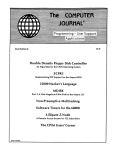Download AUTO REPAIRS MADE EASY
Transcript
AUTO REPAIRS MADE EASY By Dan Disclaimer Dan urges you to please use caution and seek professional assistance when performing repairs to your vehicle. Before attempting any repairs it is advised that you refer to your service manual or contact a certified mechanic. I am in no way responsible for any damages, injuries or other harm inflicted to your vehicle or yourself which may result in attempting these repairs. Use all safety equipment and procedures as outlined in the service manual. GM PASS-Key II Diagnosing and bypassing In this article, I will try to help you to understand and diagnose the GM PASS-key II system. The PASS-Key stands for Personal Automotive Security System. This system is designed to prevent the starter from engaging unless the proper key is used. It also will prevent the injectors from pulsing. This system uses the resistor pellet that is made into the key. Once the key is inserted into the ignition lock cylinder, it completes the circuit that the PASS-Key module monitors to tell if the correct key is used. If the Theft module does not get the correct resistance when you try to start it, It will flash the security light and the starter will not engage. The Key There are 15 different pellet used in these keys . They are idenitifed by the amount of resistance in the pellet. Here are the resistance values of each key number: VATS # K OHMS 1———— 0.402 (acceptable range .386-.438) 2———— 0.523 (acceptable range .502-.564) 3———— 0.681 (acceptable range .650-.728) 4————-0.887 (acceptable range .850-.942) 5————-1.130 (acceptable range 1.085-1.195) 6————-1.470 (acceptable range 1.411-1.549) 7————-1.870 (acceptable range 1.795-1.965) 8————-2.370 (acceptable range 2.275-2.485) 9————-3.010 (acceptable range 2.890-3.150) 10————3.740 (acceptable range 3.590-3.910) 11————4.750 (acceptable range 4.560-4.960) 12————6.040 (acceptable range 5.798-6.302) 13————7.500 (acceptable range 7.200-7.820) 14————9.530 (acceptable range 9.149-9.931) 15————11.801 (acceptable range 11.320-12.290) You can see what the resistance your key has by ohming it with an ohm meter. This key reads 3.684k ohms which is a key # 10. If you have a volt meter to select the ohm scale, set it to 20k. The Ignition Lock Cylinder The Ignition lock sensor has 2 wires attached to it that runs down the steering column. These wires are known to break from the turning of the ignition switch. If one of these wires gets broken, the security light will come on and the car may not start. To Diagnose the system, Start off by ohming the lock cylinder circuit. This is where 95% of the issues with this system is found. You have to pull the panel above the gas and brake pedal off to get to the connector. Once that panel is removed, locate the connector for the ignition lock cylinder. There are 2 white wires wrapped in an orange sleeve that comes out of the ignition column and goes toward the passenger side of the car. Unplug the connector and ohm the wire that goes to the ignition lock cylinder. With no key in the lock cylinder, It should read open or OL (out of Limits). With the key in the lock cylinder, It should read out the same or very close to the same as you ohmed the key. Rotate the key and make sure the resistance stays the same and does not go open. You can see this ohms the exact same as the key. If it would give a different resistance or stayed open, that would mean the wire for the lock cylinder may be broken inside the steering column. Bypass the lock cylinder You can bypass the lock cylinder in these cars if you want to add a remote starter or if you don’t want to replace the lock cylinder if the wires are broken. You will need a resistor that is in the acceptable range of the key # for your car. This car was a key code 10 so the acceptable range is 3.5903.910 k ohms. I went down to Radio Shack and bought a bag of resistors for less than $15. This bag had a resistor that was 3.86k ohms which falls in the acceptable range. Sometimes you have to solder 2 resistors together to get the correct range. Cut the end of the lock cylinder harness off. Strip the wires down and twist them onto the resistor and solder them together. I place some heat shrink tube over the resistor to help protect it from shorting out onto something when in the car. You can also tape it up with electrical tape. Once you get it soldered and taped up, ohm it out to make sure the resistance is in the acceptable range. Once it’s together, Plug it up and start it up. Bypassing the theft system will let you start the car up without a chip in the key. It will make it easier for someone to steal the car. If it still won’t start with the correct key resistance in it and the security light is still flashing, there could be an issue with the theft module or a wiring issue. Others articles are coming out soon to assist you in diagnosing the theft module. Feel free to contact me if you need more assistance.














